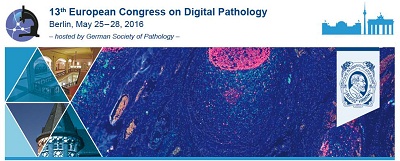A Graph-Based Digital Pathology Approach To Describe Lymphocyte Clustering Patterns After Renal Transplantation
Abstract
Introduction/ Background
Renal transplantation (rTx) induces an adaptive immune response against foreign donor antigens mediated by lymphocytes of the recipient. Local accumulation of B- and T-cells is an important component of this response enabling and controlling immune cell interactions [1]. Combining digital microscopic images with network analysis [2][3] opens new perspectives to study the spa- tial dimension of lymphocyte clustering and to model their potential interactions.
Â
Aims
The aim of this study is to characterize the range of B- and T-lymphocytic infiltrates below the threshold of rejection defined by theBanffclassification [4][5] and to propose a mathematical description of immune cell clustering for use in systems medicine approaches.
Â
Methods
We established a workflow to comprehensively characterize lymphocyte clusters and compare their morphological features with organized structures such as secondary or tertiary lymphoid organs (TLO/SLO) [6]. 51 renal protocol and indication biopsies from 13 patients without evidence for severe rejection over 10 years were stained by CD3/CD20 duplex immunohisto- chemistry. Whole slide images (WSIs) were acquired to automatically detect biologically relevant regions of in- terest (ROIs) by means of density maps for lymphocytes (image analysis workflow illustrated in Fig. 1a). They are generated from single nuclei identification using an au- to-adaptive random forest pixelwise classifier (“nucleus container†module [7],Definiens,Germany). We imple- mented a graph-based tool in Java using individual cell coordinates to identify cell compartments (Fig. 1b) and applied it to each selected ROI. For this, a neighborhood graph is built by Delaunay triangulation and Euclidean distances. This analysis allows describing their specific clustering behavior based on features as described in [8]. The convex hull of the neighborhood graph allows a visualization of B- and T-cell compartments.
Â
Results
We identified B-cell rich compartments in about 55% of 150 ROIs in kidney tissue after successful transplantation (examples in Fig. 2). The B-cell compartments in rTx tended towards smaller overall size with on average about 90 cells in a B-cell cluster compared to more than 600 B-cells observed in mature TLOs and SLOs and they showed less prominent spatial organization (average degree on average 3.92 instead of 4.97; degree shows generally Poisson distribution as illustrated in Fig. 3A). Further, the graph analysis confirmed lower B-cell density (Fig. 3B displays the exponential character of the spatial B-cell distribution in a selected ROI), a different ratio between T- and B-cell compartments, and more frequent overlap between both regions than in mature lymphoid structures.
Â
We conclude that the graph-based approach is feasible to distinguish relevant immune cell patterns in rTx and provides a useful mathematical description of neighborhood relationships between immune cells and their spatial organization. The workflow has the potential to improve throughput and robustness of immune cell evaluation for use in translational science.
Downloads
References
[2] Gunduz C., et al., The cell graphs of cancer, Bioinformatics 2004, 20 Suppl 1:i145-51.
[3] Schäfer H., et al., CD30 cell graphs of hodgkin lymphoma are not scale-free - an image analysis approach, Bioinformatics 2016, 32(1):122-9.
[4]Mengel M., et al., Infiltrates in protocol biopsies from renal allografts, Am J Transplantation 2007, 7(2):356-65.
[5] Solez K., et al., Banff 07 classification of renal allograft pathology: updates and future directions, Am J Transplantation 2008, 8(4):753-
60.
[6] Stranford S., Ruddle N.H., Follicular dendritic cells, conduits, lymphatic vessels, and high endothelial venules in tertiary lymphoid
organs: parallels with lymph node stroma, Front Immunol 2012, 3:350.
[7] Brieu N., et al., Slide specific models for segmentation of differently stained digital histopathology whole slide images, Proc. SPIE 9784,
Medical Imaging 2016: Image Processing, 978410.
[8] Barabasi A.L., Oltvai Z.N., Network biology: understanding the cell’s functional organization, Nat Rev Gen 2004, 5(2):101-13.

This work is licensed under a Creative Commons Attribution-ShareAlike 4.0 International License.
Authors who publish with this journal agree to the following terms:
1. Authors retain copyright and grant the journal right of first publication with the work simultaneously licensed under a Creative Commons Attribution License that allows others to share the work with an acknowledgement of the work's authorship and initial publication in this journal.
2. Authors are able to enter into separate, additional contractual arrangements for the non-exclusive distribution of the journal's published version of the work (e.g., post it to an institutional repository or publish it in a book), with an acknowledgement of its initial publication in this journal.
3. Authors are permitted and encouraged to post their work online (e.g., in institutional repositories or on their website) prior to and during the submission process, as it can lead to productive exchanges, as well as earlier and greater citation of published work (See The Effect of Open Access).
4. In case of virtual slide publication the authors agree to copy the article in a structural modified version to the journal's VS archive.








